
Tyumen
Encyclopedia
Tyumen is the largest city and the administrative center of Tyumen Oblast
, Russia
, located on the Tura River
2144 kilometres (1,332.2 mi) east of Moscow
. Population:
Tyumen is the oldest Russian settlement in Siberia
. Founded in 16th century to support Russia's eastward expansion, the city has remained one of the most important industrial and economic centers east of the Ural Mountains
. Located at the junction of several important trade routes and with easy access to navigable waterways, Tyumen rapidly developed from a small military settlement to a large commercial and industrial city. The central district of Old Tyumen retains many historic buildings from throughout the city's history.
Today Tyumen is one of Russia's most important business centers, it is also prominent in the political and cultural life of the country.
Tyumen is the transportation hub and industrial center of Tyumen Oblast
—a vast oil-rich region stretching from the Kazakh
border to the Arctic Ocean
—as well as the home of many companies active in Russia's oil and gas industry.
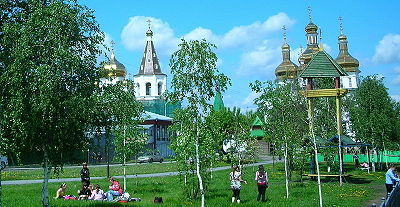
 The Tyumen area, originally part of the Siberia Khanate
The Tyumen area, originally part of the Siberia Khanate
, was annexed to Russia by the Cossack hetman
Yermak Timofeyevich
in 1585, and on July 29, 1586, Tsar Feodor I
ordered two regional commanders, Vasily Borisov Sukin and Ivan Myasnoy, to construct a fortress on the site of the former Tatar
town of Chimgi-Tura
(also sometimes known as Tumen).
 The site where Tyumen was founded corresponded to the so called "Tyumen Portage" on the historical trade route from Central Asia to the Volga region, control of which had been continuously contested by various South Siberian nomads in the preceding centuries. As a result, early Russian settlers were often attacked by Tatar and Kalmyk
The site where Tyumen was founded corresponded to the so called "Tyumen Portage" on the historical trade route from Central Asia to the Volga region, control of which had been continuously contested by various South Siberian nomads in the preceding centuries. As a result, early Russian settlers were often attacked by Tatar and Kalmyk
raiders, and until the middle of the 17th century Tyumen's population was dominated by the Streltsy
and Cossack garrisons stationed in the town. As the area became less restive, the town began to take on a less military character.
At the beginning of the 18th century Tyumen became an important center of trade between Siberia and China in the east and Central Russia in the west, as well as an important industrial center, known for its leather goods makers, blacksmiths, and other craftsmen. In 1763, 7000 people were recorded as living in the town.
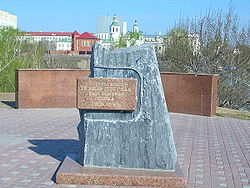 In the 19th century the town's development continued. In 1836, the first steam boat in Siberia was built in Tyumen. In 1862, the telegraph came to the town, and in 1864 the first water mains were laid. Further prosperity came to Tyumen after the construction, in 1885, of the Trans-Siberian Railway
In the 19th century the town's development continued. In 1836, the first steam boat in Siberia was built in Tyumen. In 1862, the telegraph came to the town, and in 1864 the first water mains were laid. Further prosperity came to Tyumen after the construction, in 1885, of the Trans-Siberian Railway
. For some years, Tyumen was Russia's easternmost railhead, and the site of transhipment of cargoes between the railway and the cargo boats plying the Tyumen, Tobol, Irtysh
, and Ob River
s.
By the end of the 19th century Tyumen's population exceeded 30,000, surpassing that of its northern rival Tobolsk
, and beginning a process whereby Tyumen gradually eclipsed the former regional capital. The growth of Tyumen culminated on August 14, 1944 when the city finally became the administrative center of extensive Tyumen Oblast
.
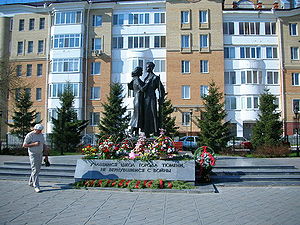 At the outbreak of the Russian Civil War
At the outbreak of the Russian Civil War
Tyumen was controlled by forces loyal to Admiral Alexander Kolchak and his Siberian White Army
; however, the city fell to the Red Army
on January 5, 1918.
During the 1930s, Tyumen became a major industrial center of the Soviet Union
. By the onset of World War II
, the city had several well established industries, including shipbuilding, furniture manufacture, and the manufacture of fur and leather goods.
World War II saw rapid growth and development in the city, as in the winter of 1941 twenty-two major industrial enterprises were evacuated to Tyumen from the European part of the Soviet Union, and were put into operation the following spring. Additionally, war-time Tyumen became a "hospital city", where thousands of wounded soldiers were treated.
During the initial stages of World War II, when it appeared possible that Moscow would fall to the advancing German Army, Tyumen also became a refuge for the body of the deceased Soviet leader Vladimir Lenin
, which was secretly moved from its mausoleum to a hidden tomb located in what is now the Tyumen State Agriculture Academy. (former Tyumen Agriculture Institute).
Between 1941 and 1945, more than 20,000 Tyumen natives saw action at the front, with almost a third, 6,000, perishing in action (the exact number of casualties is uncertain as official data include soldiers who died in hospitals in Tyumen).
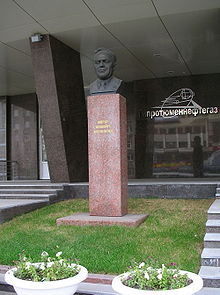
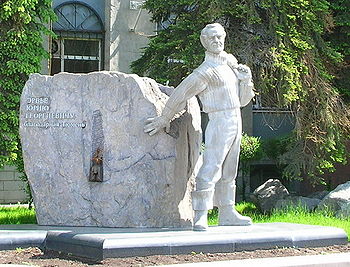 After the discovery of rich oil and gas
After the discovery of rich oil and gas
fields in Tyumen Oblast in the 1960s, Tyumen became the focus of the Soviet oil industry, and experienced a second economic and population boom. While most of the oil and gas fields were hundreds of kilometers to the north of the city, near the towns of Surgut
and Nizhnevartovsk
, Tyumen was the nearest railway junction as well as the oblast administrative center, which made it the natural site for numerous oil related enterprises which contributed to the city's development between 1963 and 1985. These years saw the arrival in Tyumen of tens of thousands of skilled workers from across the Soviet Union.
The rapid growth of the city also brought a host of unforeseen problems, as the growing population quickly outstripped the abilities of Tyumen's rather limited social infrastructure. The lack of far-sighted city planning has resulted in uneven development with which Tyumen has continued to struggle into the present.
. In addition to legislative activities, the City Duma appoints the Head of the Tyumen City Administration, who is the chief executive officer
of the city.
 Administratively, Tyumen is divided into four administrative okrugs:
Administratively, Tyumen is divided into four administrative okrugs:
, and all the governing bodies of the oblast are located in the city.
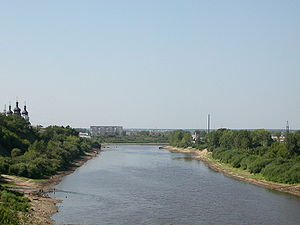 Tyumen covers an area of 235 square kilometres (90.7 sq mi). Its primary geographical feature is the Tura River
Tyumen covers an area of 235 square kilometres (90.7 sq mi). Its primary geographical feature is the Tura River
, which crosses the city from the northwest to the southeast. The river is navigable downstream of the city. The left bank of the Tura is a floodplain
surrounded by gently rolling hills. The Tura is a fairly shallow river with extensive marshlands along its shores.
The river flood
s during the snow melting season in the spring; the flood usually peaks in the second half of May, when the river becomes 8-10 times wider than during the late-summer low water season. The city is protected from flooding by a dike which can withstand floods up to 8 meters high. The highest ever flood water level in Tyumen was 9.15 m (30.02 ft), recorded in 1979; more recently, in 2007, the water level of 7.76 was recorded. In the spring 2005 a flood higher than the "critical" 8 m (26.25 ft) mark was expected, but apparently that did not happen.
(Köppen climate classification
Dfb) with warm, somewhat humid summers and long, cold winters. The weather in town is very changeable, and the temperature in town is always higher than in the surrounding area by a few degrees, and the town area attracts more precipitation. The average temperature in January is -16.7 C, with a record low of -50 C (February 1951). The average temperature in July is 18.6 °C (65.5 °F), with a record high of 38 °C (100.4 °F).
The average annual precipitation is 457 mm; the wettest year on record was 1943, with 581 mm, and the driest was 1917, with only 231 mm.
 Tyumen's population grew steadily from the 16th century through the 19th century, until the Trans-Siberian Railway came through it at the end of the 19th century. This greatly boosted the town's rate of growth, and Tyumen rapidly became the largest town in the region, with approx. 30,000 inhabitants by the beginning of the 20th century. Tyumen again experienced rapid growth with the coming of World War 2, due to the evacuation of workers from factories in central Russia in 1941, which more than doubled its population to 150,000.
Tyumen's population grew steadily from the 16th century through the 19th century, until the Trans-Siberian Railway came through it at the end of the 19th century. This greatly boosted the town's rate of growth, and Tyumen rapidly became the largest town in the region, with approx. 30,000 inhabitants by the beginning of the 20th century. Tyumen again experienced rapid growth with the coming of World War 2, due to the evacuation of workers from factories in central Russia in 1941, which more than doubled its population to 150,000.
In the 1960s, the discovery of the rich oil and gas fields in Western Siberia caused the city, which had not been forecast to exceed 250,000 that decade, to swell in size to almost half a million. The following period of stability lasted until 1988, when economic depression hit the Soviet Union. The city's population in 1989 was 476,869, according to the census of that year. Within five or six years after the slump caused by the fall of the USSR, Tyumen was again a major economic center, and its population began to slowly rise. Its population was 510,719 in 2002 and further growth, due mainly to migration and the incorporation of surrounding settlements, meant that by 2008 there were some 588,600 inhabitants, according to regional government statistics.
As of 2009, there are over ten operational Orthodox temples (both newly built and historical), two mosques (both newly built), one synagogue, and one Roman Catholic church in Tyumen.
.png)

, this religion historically prevailed in Tyumen.
In 1616, Trinity Monastery (Troitskiy Monastery - rus) was established in Tyumen by Nifont of Kazan. In 1709-1711, this monastery was rebuilt in stone by the order of Filofey Leschinsky the first Metropolitan of Siberia.
In 1761, the Tyumen Religious School was established.
Overall, from 1708 to 1885, twelve stone Orthodox temples of different size, and two monasteries were constructed in Tyumen.
During Soviet times, two of the temples were completely destroyed, but the rest remained. As of 2008, most of them are accessible and returned to operational state. At the start of 2009, one of the destroyed temples is being restored to double size at a new location, and another is under discussion.
Some operational temples are also under restoration. Tyumen Religious School was reopened in 1997.
predominance, in the past there were also constructed temples of Islam
, Catholicism
and Judaism
. Unfortunately, only the one Catholic church building remained preserved in its historical state. The Tyumen Mosque
was completely destroyed, and its reconstruction in place was considered unfair. The Tyumen synagogue had collapsed just after the year 2000, though it was reconstructed anew in the same place.
At the start of the 20th century, there was a strong Old Believers
community in Tyumen.
All four of the aforementioned religions are operating their cultural centers around town.
There are also several other religious bodies around town, but only with few adherents.
Interesting facts
Tyumen Trinity Monastery was built by the special permission of Peter the Great, owing to the fact that construction of stone buildings outside Saint Petersburg
was prohibited at the time.
Church of Savior Uncreated was visited by Crown prince
Alexandr, later Alexander II
during his Siberian tour before enthronement.
Due to its advantageous location at the crossing of the Motor, Rail, Water and Air way and its moderate climate Tyumen was an ideal base town for servicing the oil and gas industry of the West Siberia. As the result today Tyumen is the center of industry, science, culture, education and medicine.
Many world level oil and gas companies such as Gazprom
, LUKoil
and Gazpromneft
, TNK-BP
, Shell
(Salym Petroleum Development N.V.) have their representative offices in Tyumen.
There are numerous, factories, engineering companies (KCA DEUTAG
and Schlumberger
), design institutes shipyard and other oil servicing companies located in Tyumen.
Tyumen is one of the Russian towns which have its own Technopark. UTair is also based in Tyumen.
Town has a quite good selection of recreational activities of all kinds for any ages.
Tyumen is also a destination for a fair number of tourists, in particular from Germany.
There are three universities and several tens of colleges in Tyumen.
Town is one of the Medical Centers of the Russian Federation so its population can receive most of high tech medical services locally without need to go to Moscow or elsewhere.
around the foundation site of the city. The city consisted of one and two-story wooden buildings, surrounded by a number of villages. With time, the territory of the city was both developed and extended by including the surrounding settlements.
To this day, Tyumen has a rather decentralized feel, and when viewed from above, appears to be a collection of low-rise towns, with occasional clusters of tall buildings placed seemingly at random throughout.
Two areas of the city, Yamalskaya Sloboda and Republic Street are noted for having generally retained their historic character.
These sections are dominated by old brick and wooden merchant houses and buildings with the occasional intrusion of mid-century Soviet low-rise buildings.
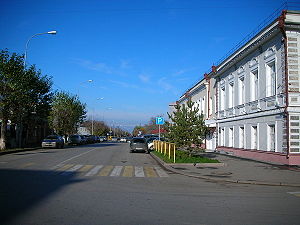

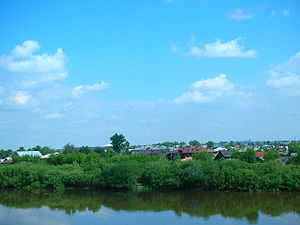
 Bukharskaya Sloboda - a Historic residential area at the low bank of Tura river . This territory is predominantly built-up with very old one-two storey lumber buildings forming a specific provincial view from Historical Center of the town (prevail Muslim population).
Bukharskaya Sloboda - a Historic residential area at the low bank of Tura river . This territory is predominantly built-up with very old one-two storey lumber buildings forming a specific provincial view from Historical Center of the town (prevail Muslim population).
Low bank Dormitories - this clusters of standard 9 stock buildings built-up at the man-made grounds east to Bukharskaya Sloboda - Zareka and Vatutina.
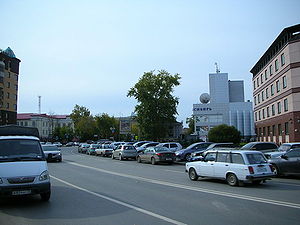
 City Center - the territory at east of the Historical town built-up between 1948 and 1978 with predominance of 4-5-story buildings. Most of the earlier buildings in this area had individual design, but the later built in rectangular style. In this area concentrated most of the political and business activities of the town.
City Center - the territory at east of the Historical town built-up between 1948 and 1978 with predominance of 4-5-story buildings. Most of the earlier buildings in this area had individual design, but the later built in rectangular style. In this area concentrated most of the political and business activities of the town.
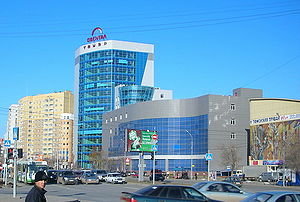
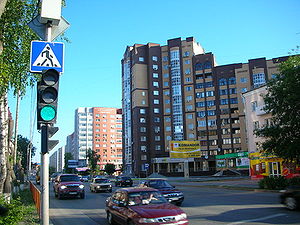 New Center - the modern territory almost at the center of the town built-up over demolished lumber houses and industrial area. In this part prevail tall buildings. Mix of the Dormitory area and business centers.
New Center - the modern territory almost at the center of the town built-up over demolished lumber houses and industrial area. In this part prevail tall buildings. Mix of the Dormitory area and business centers.
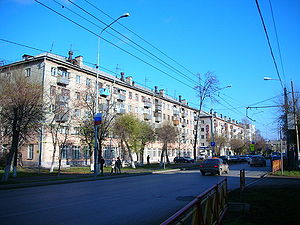
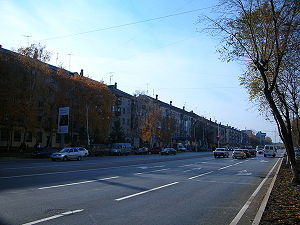 Old Dormitories - this areas built-up with standard 5 stock blocks of flats constructed in the 60th-70th at the ex west and east extremities, now they actually are in the town center. While there are almost no difference in architecture this areas are most green part of the town and have the best social infrastructure to other town parts.
Old Dormitories - this areas built-up with standard 5 stock blocks of flats constructed in the 60th-70th at the ex west and east extremities, now they actually are in the town center. While there are almost no difference in architecture this areas are most green part of the town and have the best social infrastructure to other town parts.

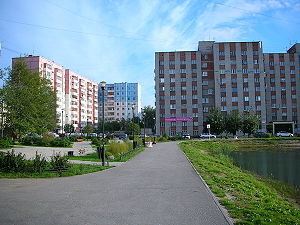 New dormitories - the clusters of standard tall buildings constructed after year 1980 at the south and south-east extremity of Tyumen. This territories are actually the worst place to live in the city while they are remote, badly planned and had very poor social infrastructure. The only pro of this areas is better ecology if compare to city center.
New dormitories - the clusters of standard tall buildings constructed after year 1980 at the south and south-east extremity of Tyumen. This territories are actually the worst place to live in the city while they are remote, badly planned and had very poor social infrastructure. The only pro of this areas is better ecology if compare to city center.
Tyumen's nickname is the Capital of Villages because the most of its the territory built up by lumber houses. But most of the people who visited Tyumen as well as a considerable part of its core dwellers mistakenly consider it is a modern high-rise town due of tall buildings concentrated along all town arterial roads.
Many of wooden buildings located in historical part of the city had cultural value:
or in Tver
. Very few slang words are in use and these are usually slang words in general use throughout Siberia.

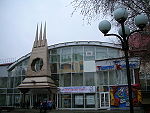
 Tyumen has a range of entertainment possibilities for all ages. There are many cinemas including two with high class stereo systems, and clubs. Tyumen has had its own Drama and Comedy Theater since 1858. There is a professional Puppet Show and the Angazhement Youth Theater. The Tyumen Music Hall is one of the most common venues for tours of Russian and World class Music Stars. The Tyumen Circus is the most contemporary in Siberia and one of the best in the whole of Russia. Tyumen offers a great variety of cuisine in its numerous restaurants and bars.
Tyumen has a range of entertainment possibilities for all ages. There are many cinemas including two with high class stereo systems, and clubs. Tyumen has had its own Drama and Comedy Theater since 1858. There is a professional Puppet Show and the Angazhement Youth Theater. The Tyumen Music Hall is one of the most common venues for tours of Russian and World class Music Stars. The Tyumen Circus is the most contemporary in Siberia and one of the best in the whole of Russia. Tyumen offers a great variety of cuisine in its numerous restaurants and bars.
There are some annual events taking place in the town such as the Student Spring Music show and Day of The Town Show.
There are 62 restaurants, 78 bars, 224 cafe, 157 snack bars in Tyumen. Only ten percent of this number is related to any local regional or international systems. The following systems represented in Tyumen (network size in brackets):
A writer closely associated with the city is the children's writer Vladislav Krapivin
. A famous Russian writer Mikhail M. Prishvin spent his youth in Tyumen as well. Viktor L. Strogalschikov one of the modern Russian writers is also living in Tyumen.
A modern Russian producer Konstantin V. Odegov was born and studied in Tyumen. Tyumen was also the location for a few episodes in Russian films.
 There are numerous museums and art galleries in Tyumen. The best known are the Tyumen Museum of Local Lore and the Tyumen Fine Art Gallery which were merged last year by local government decision.
There are numerous museums and art galleries in Tyumen. The best known are the Tyumen Museum of Local Lore and the Tyumen Fine Art Gallery which were merged last year by local government decision.
Some of the Tyumen Museums:
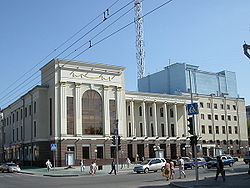 Music has always attracted the attention of Tyumen's inhabitants. The town has its own philharmonic orchestra and the Tyumen Music hall has steady auditory. While performing Russian tours Music Stars will visit the Tyumen without fail.
Music has always attracted the attention of Tyumen's inhabitants. The town has its own philharmonic orchestra and the Tyumen Music hall has steady auditory. While performing Russian tours Music Stars will visit the Tyumen without fail.
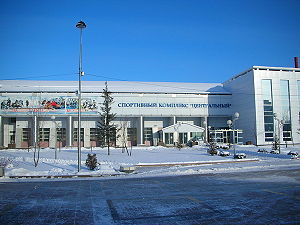 For many years Tyumen was the source for the Soviet and the Russian sport reserve.
For many years Tyumen was the source for the Soviet and the Russian sport reserve.
Many of the most famous Soviet and Russian sportsmen started their career in Tyumen youth sport including Soviet cycle racing stars Sergey Uslamin,Yuriy Korotkih and Oleg Polovnikov.
There are some Tyumen Biathlonists in the current Russian national team.
Today Tyumen offers a number of sport activities for all ages. There are numerous sport and fitness clubs around the town.
Tyumen has a National Level Soccer Team, Hockey
team and Futsal
team.
There are three all season ice arenas, a soccer field (amateur fields are not counted), a ski centre, a hippodrome, a shooting range, several tennis-courts including in the open and all season, three Olympic sized pools. In winter time parks for the cross country skiing are available around the town.
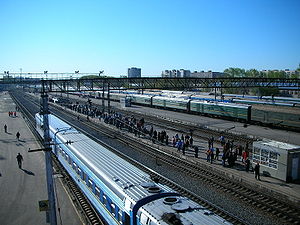
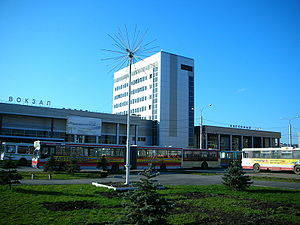 Tyumen Rail Station was founded in 1885. Currently Station Administratively belongs to the Tyumen Division of Sverdlovskaya Rail Road.
Tyumen Rail Station was founded in 1885. Currently Station Administratively belongs to the Tyumen Division of Sverdlovskaya Rail Road.
Station is located in the very center of the Tyumen city in 15 minutes walk south from the city hall. Station services suburban, intercity and international passenger traffic.
At the regional level the station services three directions to Yekaterinburg
, to Omsk
and to Tobolsk
. Railroad to Yekaterinburg electrified since 1980.
Direct international passenger directions(Trans-Siberian Railway
): Poland
, Germany
, China
, Mongolia
.
Additional stations within city territory: Tyumen North, Tyumen yard, Voynovka yard.
General Information:
Tyumen Station Passenger Terminal Data:
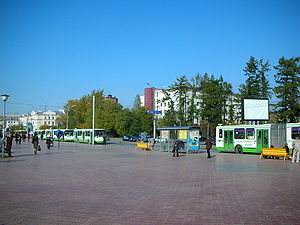 Public transportation in Tyumen is dominated by both municipal bus services and by numerous private operators (marshrutka
Public transportation in Tyumen is dominated by both municipal bus services and by numerous private operators (marshrutka
s), which account for nearly a third of all transport capacity. The city's bus fleet is in process of modernization and expansion, with newly acquired Russian buses replacing the severely aged soviet models.
As of 2009 the city of Tyumen is served by the following:
Total Number of routes - 131 (previous estimates April 2009 - 134; Jan. 2005 - 64)
Total Length of Routes - 2 131,80 km (valid until 1 September 2009)
Total Number of vehicles - 1152 (previous estimates April 2009 - 1207; Jan. 2008 - 880)
Suburban and intercity transport
Tyumen is a major hub for intercity bus service, centered on the bus-terminal, which was constructed in 1972, and greatly expanded between 2006 and 2008.
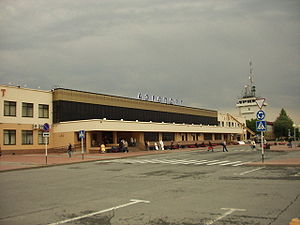 Tyumen is served by the international Roschino Airport located 13 km west of the city.
Tyumen is served by the international Roschino Airport located 13 km west of the city.
The airport has permit to handle with the following types of aircrafts: Tu-154
, Tu-134
, An-12
, An-24
, An-26
, Yak-40
, Yak-42
, IL-18
, L-410, B-737, B-757 IL-86
, IL-76
, ATR-42
, ATR-72
, HS-125
.
The airport has permit to handle with all types of helicopters.
The airstrip is capable to handle with huge aircrafts such as An-22 Antaeus)
.
City has a regular service to the large number of Russian towns include such important as:
There are also weekly or biweekly flights to the following international locations:
Tyumneka River and Trans-Siberian Railroad, creating several isolated zones. Seven bridges, one footbridge, five flyovers, and five foot crossings connect these zones.
In addition, the Tyumen Road network was planned before the fall of the Soviet Union and in its current state, it is capable to operate normally only in the scheme which includes public transportation only. Compact planning of city center prevents expansion of main roads; congestion coming from the city perephery moves slower and slower as it approaches the town center. To date, the road network is congested about 200% above capacity, which leads to numerous traffic jams and high accident rates.
Since 2002, city and regional authorities have undertaken numerous initiatives to improve Tyumen road network; due to growth of private automobile ownership, this all had only a short term effect. To date, a complex transport infrastructure reconstruction project is being directed by Regional Administration.
Important note - most students are not counted in the city population since they are non-residents of the Tyumen city according to Russian law.
with: Bern, Switzerland
(2007) Brest
, Belarus
(1999) Calgary
, Canada
Celle
, Germany
(1994) Daqing
, China
(1993) Houston, Texas
, United States
(1995)
Tyumen Oblast
Tyumen Oblast is a federal subject of Russia . Its administrative center is the city of Tyumen. The oblast has administrative jurisdiction over two autonomous okrugs—Khanty-Mansi Autonomous Okrug and Yamalo-Nenets Autonomous Okrug. Tyumen is the largest city, with over half a million inhabitants...
, Russia
Russia
Russia or , officially known as both Russia and the Russian Federation , is a country in northern Eurasia. It is a federal semi-presidential republic, comprising 83 federal subjects...
, located on the Tura River
Tura River
Tura River , also known as Dolgaya River ) is a historically important Siberian river which flows eastward from the central Ural Mountains into the Tobol River, a part of the Ob River basin. The main town is Tyumen....
2144 kilometres (1,332.2 mi) east of Moscow
Moscow
Moscow is the capital, the most populous city, and the most populous federal subject of Russia. The city is a major political, economic, cultural, scientific, religious, financial, educational, and transportation centre of Russia and the continent...
. Population:
Tyumen is the oldest Russian settlement in Siberia
Siberia
Siberia is an extensive region constituting almost all of Northern Asia. Comprising the central and eastern portion of the Russian Federation, it was part of the Soviet Union from its beginning, as its predecessor states, the Tsardom of Russia and the Russian Empire, conquered it during the 16th...
. Founded in 16th century to support Russia's eastward expansion, the city has remained one of the most important industrial and economic centers east of the Ural Mountains
Ural Mountains
The Ural Mountains , or simply the Urals, are a mountain range that runs approximately from north to south through western Russia, from the coast of the Arctic Ocean to the Ural River and northwestern Kazakhstan. Their eastern side is usually considered the natural boundary between Europe and Asia...
. Located at the junction of several important trade routes and with easy access to navigable waterways, Tyumen rapidly developed from a small military settlement to a large commercial and industrial city. The central district of Old Tyumen retains many historic buildings from throughout the city's history.
Today Tyumen is one of Russia's most important business centers, it is also prominent in the political and cultural life of the country.
Tyumen is the transportation hub and industrial center of Tyumen Oblast
Tyumen Oblast
Tyumen Oblast is a federal subject of Russia . Its administrative center is the city of Tyumen. The oblast has administrative jurisdiction over two autonomous okrugs—Khanty-Mansi Autonomous Okrug and Yamalo-Nenets Autonomous Okrug. Tyumen is the largest city, with over half a million inhabitants...
—a vast oil-rich region stretching from the Kazakh
Kazakhstan
Kazakhstan , officially the Republic of Kazakhstan, is a transcontinental country in Central Asia and Eastern Europe. Ranked as the ninth largest country in the world, it is also the world's largest landlocked country; its territory of is greater than Western Europe...
border to the Arctic Ocean
Arctic Ocean
The Arctic Ocean, located in the Northern Hemisphere and mostly in the Arctic north polar region, is the smallest and shallowest of the world's five major oceanic divisions...
—as well as the home of many companies active in Russia's oil and gas industry.
History


Siberia Khanate
The Khanate of Sibir were the patrilineal descendants of Shayban , the fifth son of Jochi and grandson of Genghis Khan. The Khanate had an ethnically diverse population of Siberian Tatars, Khanty, Mansi, Nenets and Selkup people. Along with the Khanate of Kazan it was the northernmost Muslim state....
, was annexed to Russia by the Cossack hetman
Hetman
Hetman was the title of the second-highest military commander in 15th- to 18th-century Poland and the Grand Duchy of Lithuania, which together, from 1569 to 1795, comprised the Polish-Lithuanian Commonwealth, or Rzeczpospolita....
Yermak Timofeyevich
Yermak Timofeyevich
Yermak Timofeyevich , Cossack leader, Russian folk hero and explorer of Siberia. His exploration of Siberia marked the beginning of the expansion of Russia towards this region and its colonization...
in 1585, and on July 29, 1586, Tsar Feodor I
Feodor I of Russia
Fyodor I Ivanovich 1598) was the last Rurikid Tsar of Russia , son of Ivan IV and Anastasia Romanovna. In English he is sometimes called Feodor the Bellringer in consequence of his strong faith and inclination to travel the land and ring the bells at churches. However, in Russian the name...
ordered two regional commanders, Vasily Borisov Sukin and Ivan Myasnoy, to construct a fortress on the site of the former Tatar
Tatars
Tatars are a Turkic speaking ethnic group , numbering roughly 7 million.The majority of Tatars live in the Russian Federation, with a population of around 5.5 million, about 2 million of which in the republic of Tatarstan.Significant minority populations are found in Uzbekistan, Kazakhstan,...
town of Chimgi-Tura
Chimgi-Tura
Chimgi-Tura - was a medieval city of Siberian Tatars in 12th-16th centuries located in Western Siberia.It was a capital of Tyumen Khanate until early 16th century when its ruler Khan Muhammad conquered Sibir and created Siberian Khanate encompassing the whole Western Siberia with a capital in...
(also sometimes known as Tumen).

Kalmyk people
Kalmyk people is the name given to the Oirats, western Mongols in Russia, whose descendants migrated from Dzhungaria in 1607. Today they form a majority in the autonomous Republic of Kalmykia on the western shore of the Caspian Sea. Kalmykia is Europe's only Buddhist government...
raiders, and until the middle of the 17th century Tyumen's population was dominated by the Streltsy
Streltsy
Streltsy were the units of Russian guardsmen in the 16th - early 18th centuries, armed with firearms. They are also collectively known as Marksman Troops .- Origins and organization :...
and Cossack garrisons stationed in the town. As the area became less restive, the town began to take on a less military character.
At the beginning of the 18th century Tyumen became an important center of trade between Siberia and China in the east and Central Russia in the west, as well as an important industrial center, known for its leather goods makers, blacksmiths, and other craftsmen. In 1763, 7000 people were recorded as living in the town.

Trans-Siberian Railway
The Trans-Siberian Railway is a network of railways connecting Moscow with the Russian Far East and the Sea of Japan. It is the longest railway in the world...
. For some years, Tyumen was Russia's easternmost railhead, and the site of transhipment of cargoes between the railway and the cargo boats plying the Tyumen, Tobol, Irtysh
Irtysh
The Irtysh River is a river in Siberia and is the chief tributary of the Ob River. Its name means White River. Irtysh's main affluent is the Tobol River...
, and Ob River
Ob River
The Ob River , also Obi, is a major river in western Siberia, Russia and is the world's seventh longest river. It is the westernmost of the three great Siberian rivers that flow into the Arctic Ocean .The Gulf of Ob is the world's longest estuary.-Names:The Ob is known to the Khanty people as the...
s.
By the end of the 19th century Tyumen's population exceeded 30,000, surpassing that of its northern rival Tobolsk
Tobolsk
Tobolsk is a town in Tyumen Oblast, Russia, located at the confluence of the Tobol and Irtysh Rivers. It is a historic capital of Siberia. Population: -History:...
, and beginning a process whereby Tyumen gradually eclipsed the former regional capital. The growth of Tyumen culminated on August 14, 1944 when the city finally became the administrative center of extensive Tyumen Oblast
Tyumen Oblast
Tyumen Oblast is a federal subject of Russia . Its administrative center is the city of Tyumen. The oblast has administrative jurisdiction over two autonomous okrugs—Khanty-Mansi Autonomous Okrug and Yamalo-Nenets Autonomous Okrug. Tyumen is the largest city, with over half a million inhabitants...
.

Russian Civil War
The Russian Civil War was a multi-party war that occurred within the former Russian Empire after the Russian provisional government collapsed to the Soviets, under the domination of the Bolshevik party. Soviet forces first assumed power in Petrograd The Russian Civil War (1917–1923) was a...
Tyumen was controlled by forces loyal to Admiral Alexander Kolchak and his Siberian White Army
White movement
The White movement and its military arm the White Army - known as the White Guard or the Whites - was a loose confederation of Anti-Communist forces.The movement comprised one of the politico-military Russian forces who fought...
; however, the city fell to the Red Army
Red Army
The Workers' and Peasants' Red Army started out as the Soviet Union's revolutionary communist combat groups during the Russian Civil War of 1918-1922. It grew into the national army of the Soviet Union. By the 1930s the Red Army was among the largest armies in history.The "Red Army" name refers to...
on January 5, 1918.
During the 1930s, Tyumen became a major industrial center of the Soviet Union
Soviet Union
The Soviet Union , officially the Union of Soviet Socialist Republics , was a constitutionally socialist state that existed in Eurasia between 1922 and 1991....
. By the onset of World War II
World War II
World War II, or the Second World War , was a global conflict lasting from 1939 to 1945, involving most of the world's nations—including all of the great powers—eventually forming two opposing military alliances: the Allies and the Axis...
, the city had several well established industries, including shipbuilding, furniture manufacture, and the manufacture of fur and leather goods.
World War II saw rapid growth and development in the city, as in the winter of 1941 twenty-two major industrial enterprises were evacuated to Tyumen from the European part of the Soviet Union, and were put into operation the following spring. Additionally, war-time Tyumen became a "hospital city", where thousands of wounded soldiers were treated.
During the initial stages of World War II, when it appeared possible that Moscow would fall to the advancing German Army, Tyumen also became a refuge for the body of the deceased Soviet leader Vladimir Lenin
Vladimir Lenin
Vladimir Ilyich Lenin was a Russian Marxist revolutionary and communist politician who led the October Revolution of 1917. As leader of the Bolsheviks, he headed the Soviet state during its initial years , as it fought to establish control of Russia in the Russian Civil War and worked to create a...
, which was secretly moved from its mausoleum to a hidden tomb located in what is now the Tyumen State Agriculture Academy. (former Tyumen Agriculture Institute).
Between 1941 and 1945, more than 20,000 Tyumen natives saw action at the front, with almost a third, 6,000, perishing in action (the exact number of casualties is uncertain as official data include soldiers who died in hospitals in Tyumen).


Natural gas
Natural gas is a naturally occurring gas mixture consisting primarily of methane, typically with 0–20% higher hydrocarbons . It is found associated with other hydrocarbon fuel, in coal beds, as methane clathrates, and is an important fuel source and a major feedstock for fertilizers.Most natural...
fields in Tyumen Oblast in the 1960s, Tyumen became the focus of the Soviet oil industry, and experienced a second economic and population boom. While most of the oil and gas fields were hundreds of kilometers to the north of the city, near the towns of Surgut
Surgut
Surgut is a city in Khanty-Mansi Autonomous Okrug, Russia, located on the Ob River near its junction with the Irtysh River, the largest in the autonomous okrug and the second largest in Tyumen Oblast. Population:...
and Nizhnevartovsk
Nizhnevartovsk
Nizhnevartovsk is the second largest city in Khanty–Mansi Autonomous Okrug, Russia, located along the right bank of the Ob River. Population: 251,860 ; 239,044 ;...
, Tyumen was the nearest railway junction as well as the oblast administrative center, which made it the natural site for numerous oil related enterprises which contributed to the city's development between 1963 and 1985. These years saw the arrival in Tyumen of tens of thousands of skilled workers from across the Soviet Union.
The rapid growth of the city also brought a host of unforeseen problems, as the growing population quickly outstripped the abilities of Tyumen's rather limited social infrastructure. The lack of far-sighted city planning has resulted in uneven development with which Tyumen has continued to struggle into the present.
City government
The legislative authority of Tyumen is the City DumaDuma
A Duma is any of various representative assemblies in modern Russia and Russian history. The State Duma in the Russian Empire and Russian Federation corresponds to the lower house of the parliament. Simply it is a form of Russian governmental institution, that was formed during the reign of the...
. In addition to legislative activities, the City Duma appoints the Head of the Tyumen City Administration, who is the chief executive officer
Mayor
In many countries, a Mayor is the highest ranking officer in the municipal government of a town or a large urban city....
of the city.
City divisions

- Kalininsky
- Leninsky
- Tsentralny
- Vostochny
Oblast government
Tyumen is the administrative center of Tyumen OblastTyumen Oblast
Tyumen Oblast is a federal subject of Russia . Its administrative center is the city of Tyumen. The oblast has administrative jurisdiction over two autonomous okrugs—Khanty-Mansi Autonomous Okrug and Yamalo-Nenets Autonomous Okrug. Tyumen is the largest city, with over half a million inhabitants...
, and all the governing bodies of the oblast are located in the city.
- Elected Legislative Assembly (Duma) of the Tyumen Province is the legislature of Tyumen Oblast. It also confirms the appointment of the Governor of Tyumen Oblast, nominated by the PresidentPresidentA president is a leader of an organization, company, trade union, university, or country.Etymologically, a president is one who presides, who sits in leadership...
of the Russian Federation; - Office of the Governor - Head of the executive authority of Tyumen Oblast;
- Government of Tyumen Oblast - Executive authority of Tyumen Oblast;
- Arbitration Tribunal of Tyumen Province - Judiciary;
- Law enforcement:
Geography

Tura River
Tura River , also known as Dolgaya River ) is a historically important Siberian river which flows eastward from the central Ural Mountains into the Tobol River, a part of the Ob River basin. The main town is Tyumen....
, which crosses the city from the northwest to the southeast. The river is navigable downstream of the city. The left bank of the Tura is a floodplain
Floodplain
A floodplain, or flood plain, is a flat or nearly flat land adjacent a stream or river that stretches from the banks of its channel to the base of the enclosing valley walls and experiences flooding during periods of high discharge...
surrounded by gently rolling hills. The Tura is a fairly shallow river with extensive marshlands along its shores.
The river flood
Flood
A flood is an overflow of an expanse of water that submerges land. The EU Floods directive defines a flood as a temporary covering by water of land not normally covered by water...
s during the snow melting season in the spring; the flood usually peaks in the second half of May, when the river becomes 8-10 times wider than during the late-summer low water season. The city is protected from flooding by a dike which can withstand floods up to 8 meters high. The highest ever flood water level in Tyumen was 9.15 m (30.02 ft), recorded in 1979; more recently, in 2007, the water level of 7.76 was recorded. In the spring 2005 a flood higher than the "critical" 8 m (26.25 ft) mark was expected, but apparently that did not happen.
Climate
Tyumen has a humid continental climateHumid continental climate
A humid continental climate is a climatic region typified by large seasonal temperature differences, with warm to hot summers and cold winters....
(Köppen climate classification
Köppen climate classification
The Köppen climate classification is one of the most widely used climate classification systems. It was first published by Crimea German climatologist Wladimir Köppen in 1884, with several later modifications by Köppen himself, notably in 1918 and 1936...
Dfb) with warm, somewhat humid summers and long, cold winters. The weather in town is very changeable, and the temperature in town is always higher than in the surrounding area by a few degrees, and the town area attracts more precipitation. The average temperature in January is -16.7 C, with a record low of -50 C (February 1951). The average temperature in July is 18.6 °C (65.5 °F), with a record high of 38 °C (100.4 °F).
The average annual precipitation is 457 mm; the wettest year on record was 1943, with 581 mm, and the driest was 1917, with only 231 mm.
Demographics

In the 1960s, the discovery of the rich oil and gas fields in Western Siberia caused the city, which had not been forecast to exceed 250,000 that decade, to swell in size to almost half a million. The following period of stability lasted until 1988, when economic depression hit the Soviet Union. The city's population in 1989 was 476,869, according to the census of that year. Within five or six years after the slump caused by the fall of the USSR, Tyumen was again a major economic center, and its population began to slowly rise. Its population was 510,719 in 2002 and further growth, due mainly to migration and the incorporation of surrounding settlements, meant that by 2008 there were some 588,600 inhabitants, according to regional government statistics.
Ethnic groups
While the population of Tyumen includes people from over a hundred different nationalities, most belong to one of the following nationalities, from traditional oil- and gas-producing regions:- RussiansRussiansThe Russian people are an East Slavic ethnic group native to Russia, speaking the Russian language and primarily living in Russia and neighboring countries....
; - UkrainiansUkrainiansUkrainians are an East Slavic ethnic group native to Ukraine, which is the sixth-largest nation in Europe. The Constitution of Ukraine applies the term 'Ukrainians' to all its citizens...
; - TatarsTatarsTatars are a Turkic speaking ethnic group , numbering roughly 7 million.The majority of Tatars live in the Russian Federation, with a population of around 5.5 million, about 2 million of which in the republic of Tatarstan.Significant minority populations are found in Uzbekistan, Kazakhstan,...
Religion
From its foundation, Tyumen was a religious center.As of 2009, there are over ten operational Orthodox temples (both newly built and historical), two mosques (both newly built), one synagogue, and one Roman Catholic church in Tyumen.
.png)

Orthodox Christianity
While the state religion of the Russian Empire was OrthodoxyOrthodoxy
The word orthodox, from Greek orthos + doxa , is generally used to mean the adherence to accepted norms, more specifically to creeds, especially in religion...
, this religion historically prevailed in Tyumen.
In 1616, Trinity Monastery (Troitskiy Monastery - rus) was established in Tyumen by Nifont of Kazan. In 1709-1711, this monastery was rebuilt in stone by the order of Filofey Leschinsky the first Metropolitan of Siberia.
In 1761, the Tyumen Religious School was established.
Overall, from 1708 to 1885, twelve stone Orthodox temples of different size, and two monasteries were constructed in Tyumen.
During Soviet times, two of the temples were completely destroyed, but the rest remained. As of 2008, most of them are accessible and returned to operational state. At the start of 2009, one of the destroyed temples is being restored to double size at a new location, and another is under discussion.
Some operational temples are also under restoration. Tyumen Religious School was reopened in 1997.
Other religions
Regardless of OrthodoxyOrthodoxy
The word orthodox, from Greek orthos + doxa , is generally used to mean the adherence to accepted norms, more specifically to creeds, especially in religion...
predominance, in the past there were also constructed temples of Islam
Islam
Islam . The most common are and . : Arabic pronunciation varies regionally. The first vowel ranges from ~~. The second vowel ranges from ~~~...
, Catholicism
Catholicism
Catholicism is a broad term for the body of the Catholic faith, its theologies and doctrines, its liturgical, ethical, spiritual, and behavioral characteristics, as well as a religious people as a whole....
and Judaism
Judaism
Judaism ) is the "religion, philosophy, and way of life" of the Jewish people...
. Unfortunately, only the one Catholic church building remained preserved in its historical state. The Tyumen Mosque
Mosque
A mosque is a place of worship for followers of Islam. The word is likely to have entered the English language through French , from Portuguese , from Spanish , and from Berber , ultimately originating in — . The Arabic word masjid literally means a place of prostration...
was completely destroyed, and its reconstruction in place was considered unfair. The Tyumen synagogue had collapsed just after the year 2000, though it was reconstructed anew in the same place.
At the start of the 20th century, there was a strong Old Believers
Old Believers
In the context of Russian Orthodox church history, the Old Believers separated after 1666 from the official Russian Orthodox Church as a protest against church reforms introduced by Patriarch Nikon between 1652–66...
community in Tyumen.
All four of the aforementioned religions are operating their cultural centers around town.
There are also several other religious bodies around town, but only with few adherents.
Interesting facts
Tyumen Trinity Monastery was built by the special permission of Peter the Great, owing to the fact that construction of stone buildings outside Saint Petersburg
Saint Petersburg
Saint Petersburg is a city and a federal subject of Russia located on the Neva River at the head of the Gulf of Finland on the Baltic Sea...
was prohibited at the time.
Church of Savior Uncreated was visited by Crown prince
Crown Prince
A crown prince or crown princess is the heir or heiress apparent to the throne in a royal or imperial monarchy. The wife of a crown prince is also titled crown princess....
Alexandr, later Alexander II
Alexander II of Russia
Alexander II , also known as Alexander the Liberator was the Emperor of the Russian Empire from 3 March 1855 until his assassination in 1881...
during his Siberian tour before enthronement.
Economy
Tyumen is an important service center for the gas and oil industries in Russia.Due to its advantageous location at the crossing of the Motor, Rail, Water and Air way and its moderate climate Tyumen was an ideal base town for servicing the oil and gas industry of the West Siberia. As the result today Tyumen is the center of industry, science, culture, education and medicine.
Many world level oil and gas companies such as Gazprom
Gazprom
Open Joint Stock Company Gazprom is the largest extractor of natural gas in the world and the largest Russian company. Its headquarters are in Cheryomushki District, South-Western Administrative Okrug, Moscow...
, LUKoil
LUKoil
Lukoil/LUKoil ; ) is Russia's second largest oil company and its second largest producer of oil. In 2009, the company produced 97.615 million tons of oil; ....
and Gazpromneft
Gazpromneft
This article is about a former subsidiary of Gazprom. For the current oil arm of Gazprom, see Gazprom Neft.Invest Union is a Russian company based in St. Petersburg and a former subsidiary of Gazprom...
, TNK-BP
TNK-BP
TNK-BP is a major vertically integrated Russian oil company. It is Russia's third largest oil producer and among the ten largest private oil companies in the world. TNK-BP is Russia's third largest oil company in terms of reserves and crude oil production...
, Shell
Royal Dutch Shell
Royal Dutch Shell plc , commonly known as Shell, is a global oil and gas company headquartered in The Hague, Netherlands and with its registered office in London, United Kingdom. It is the fifth-largest company in the world according to a composite measure by Forbes magazine and one of the six...
(Salym Petroleum Development N.V.) have their representative offices in Tyumen.
There are numerous, factories, engineering companies (KCA DEUTAG
KCA DEUTAG
KCA DEUTAG is an international oil and gas services company with headquarters in Aberdeen, United Kingdom. It has approximately 8,000 employees and operates in more than 20 countries worldwide.-Background:...
and Schlumberger
Schlumberger
Schlumberger Limited is the world's largest oilfield services company. Schlumberger employs over 110,000 people of more than 140 nationalities working in approximately 80 countries...
), design institutes shipyard and other oil servicing companies located in Tyumen.
Tyumen is one of the Russian towns which have its own Technopark. UTair is also based in Tyumen.
Town has a quite good selection of recreational activities of all kinds for any ages.
Tyumen is also a destination for a fair number of tourists, in particular from Germany.
There are three universities and several tens of colleges in Tyumen.
Town is one of the Medical Centers of the Russian Federation so its population can receive most of high tech medical services locally without need to go to Moscow or elsewhere.
Overview
Historically, Tyumen occupied a small area on the high bank of the Tura RiverTura River
Tura River , also known as Dolgaya River ) is a historically important Siberian river which flows eastward from the central Ural Mountains into the Tobol River, a part of the Ob River basin. The main town is Tyumen....
around the foundation site of the city. The city consisted of one and two-story wooden buildings, surrounded by a number of villages. With time, the territory of the city was both developed and extended by including the surrounding settlements.
To this day, Tyumen has a rather decentralized feel, and when viewed from above, appears to be a collection of low-rise towns, with occasional clusters of tall buildings placed seemingly at random throughout.
Two areas of the city, Yamalskaya Sloboda and Republic Street are noted for having generally retained their historic character.
These sections are dominated by old brick and wooden merchant houses and buildings with the occasional intrusion of mid-century Soviet low-rise buildings.




Low bank Dormitories - this clusters of standard 9 stock buildings built-up at the man-made grounds east to Bukharskaya Sloboda - Zareka and Vatutina.








Architecture
Tyumen is too diverse to be characterized by any particular architectural style, and it generally has no overall style whatsoever. The town was built and non-planned for decades and because of that its architecture is an eclectic mix of buildings of different styles and eras.Tyumen's nickname is the Capital of Villages because the most of its the territory built up by lumber houses. But most of the people who visited Tyumen as well as a considerable part of its core dwellers mistakenly consider it is a modern high-rise town due of tall buildings concentrated along all town arterial roads.
Many of wooden buildings located in historical part of the city had cultural value:
Parks and gardens
There are many parks and Gardens of different size located around the Tyumen making town landscape green and fresh. Some of this parks also has sport and entertaining components.Accent
The phenomenon of Tyumen is accent absence. During all its history Tyumen language environment was never isolated long enough to form any kind of accent. As a merchant town Tyumen permanently kept in contact with Russian capital territories and always received many people from all over the country. This fact furthered the preservation of literary language and to the present day people in Tyumen speak Russian completely the same as the people in Saint PetersburgSaint Petersburg
Saint Petersburg is a city and a federal subject of Russia located on the Neva River at the head of the Gulf of Finland on the Baltic Sea...
or in Tver
Tver
Tver is a city and the administrative center of Tver Oblast, Russia. Population: 403,726 ; 408,903 ;...
. Very few slang words are in use and these are usually slang words in general use throughout Siberia.
Leisure and entertainment



There are some annual events taking place in the town such as the Student Spring Music show and Day of The Town Show.
There are 62 restaurants, 78 bars, 224 cafe, 157 snack bars in Tyumen. Only ten percent of this number is related to any local regional or international systems. The following systems represented in Tyumen (network size in brackets):
Literature and film
Tyumen has not been the setting for too many works of literature however there were some poets and writers in the town history.A writer closely associated with the city is the children's writer Vladislav Krapivin
Vladislav Krapivin
Vladislav Petrovich Krapivin is a Russian children's books writer.- Biography :Vladislav Petrovich Krapivin was born in the city of Tyumen on 14 October 1938. He received a degree in journalism from the Ural State University. In the course of his studies, he started working at the newspaper...
. A famous Russian writer Mikhail M. Prishvin spent his youth in Tyumen as well. Viktor L. Strogalschikov one of the modern Russian writers is also living in Tyumen.
A modern Russian producer Konstantin V. Odegov was born and studied in Tyumen. Tyumen was also the location for a few episodes in Russian films.
Museums and art galleries

Some of the Tyumen Museums:
- Tyumen Museum of Local Lore (Several exhibition halls)
- Museum of Geology
- Museum of the Fine Arts
- Museum of Kolokolnikov estate (Several exhibition halls)
- House of Merchant Masharov
- Medical History Museum
- Museum of Tyumen Agricultural Academy (includes - local Lore exhibition, Museum of anatomy; Museum of soil science)
Music

Sports

Many of the most famous Soviet and Russian sportsmen started their career in Tyumen youth sport including Soviet cycle racing stars Sergey Uslamin,Yuriy Korotkih and Oleg Polovnikov.
There are some Tyumen Biathlonists in the current Russian national team.
Today Tyumen offers a number of sport activities for all ages. There are numerous sport and fitness clubs around the town.
Tyumen has a National Level Soccer Team, Hockey
Hockey
Hockey is a family of sports in which two teams play against each other by trying to maneuver a ball or a puck into the opponent's goal using a hockey stick.-Etymology:...
team and Futsal
Futsal
Futsal is a variant of association football that is played on a smaller pitch and mainly played indoors. Its name is a portmanteau of the Portuguese futebol de salão and the Spanish fútbol de salón , which can be translated as "hall football" or "indoor football"...
team.
There are three all season ice arenas, a soccer field (amateur fields are not counted), a ski centre, a hippodrome, a shooting range, several tennis-courts including in the open and all season, three Olympic sized pools. In winter time parks for the cross country skiing are available around the town.
- FC TyumenFC TyumenFC Tyumen is a Russian football club based in Tyumen. The former member of the Russian Premier League, Tyumen plays in the Second Division.The club was previously known as Geolog , Priboy , Neftyanik , Stroitel , Fakel FC Tyumen is a Russian football club based in Tyumen. The former member of the...
Railway


Station is located in the very center of the Tyumen city in 15 minutes walk south from the city hall. Station services suburban, intercity and international passenger traffic.
At the regional level the station services three directions to Yekaterinburg
Yekaterinburg
Yekaterinburg is a major city in the central part of Russia, the administrative center of Sverdlovsk Oblast. Situated on the eastern side of the Ural mountain range, it is the main industrial and cultural center of the Urals Federal District with a population of 1,350,136 , making it Russia's...
, to Omsk
Omsk
-History:The wooden fort of Omsk was erected in 1716 to protect the expanding Russian frontier along the Ishim and the Irtysh rivers against the Kyrgyz nomads of the Steppes...
and to Tobolsk
Tobolsk
Tobolsk is a town in Tyumen Oblast, Russia, located at the confluence of the Tobol and Irtysh Rivers. It is a historic capital of Siberia. Population: -History:...
. Railroad to Yekaterinburg electrified since 1980.
Direct international passenger directions(Trans-Siberian Railway
Trans-Siberian Railway
The Trans-Siberian Railway is a network of railways connecting Moscow with the Russian Far East and the Sea of Japan. It is the longest railway in the world...
): Poland
Poland
Poland , officially the Republic of Poland , is a country in Central Europe bordered by Germany to the west; the Czech Republic and Slovakia to the south; Ukraine, Belarus and Lithuania to the east; and the Baltic Sea and Kaliningrad Oblast, a Russian exclave, to the north...
, Germany
Germany
Germany , officially the Federal Republic of Germany , is a federal parliamentary republic in Europe. The country consists of 16 states while the capital and largest city is Berlin. Germany covers an area of 357,021 km2 and has a largely temperate seasonal climate...
, China
China
Chinese civilization may refer to:* China for more general discussion of the country.* Chinese culture* Greater China, the transnational community of ethnic Chinese.* History of China* Sinosphere, the area historically affected by Chinese culture...
, Mongolia
Mongolia
Mongolia is a landlocked country in East and Central Asia. It is bordered by Russia to the north and China to the south, east and west. Although Mongolia does not share a border with Kazakhstan, its western-most point is only from Kazakhstan's eastern tip. Ulan Bator, the capital and largest...
.
Additional stations within city territory: Tyumen North, Tyumen yard, Voynovka yard.
General Information:
- Traffic flow per year - over 10 million passengers.
- Platforms number - 4;
- Platform type - open
- Railway tracks number - 9
Tyumen Station Passenger Terminal Data:
- Open - 24/365
- Waiting rooms total capacity - 1500 passengers;
- Space of total - 8300 m2;
- Booking hall space - 1790 m2;
- Number of ticket windows - 11;
- Payment terminals - yes;
- Invalid carriages capable - yes;
- Security: regular police, armed guard, video surveillance, video recording
City Bus
Urban transport
Marshrutka
Marshrutka , from marshrutnoye taksi is a share taxi in the CIS countries, the Baltic states, and Bulgaria. Marshrutnoye taksi literally means routed taxicab...
s), which account for nearly a third of all transport capacity. The city's bus fleet is in process of modernization and expansion, with newly acquired Russian buses replacing the severely aged soviet models.
As of 2009 the city of Tyumen is served by the following:
Total Number of routes - 131 (previous estimates April 2009 - 134; Jan. 2005 - 64)
- city routes - 84
- commuter routes - 47
Total Length of Routes - 2 131,80 km (valid until 1 September 2009)
Total Number of vehicles - 1152 (previous estimates April 2009 - 1207; Jan. 2008 - 880)
- shared-ride taxis - 608
- municipal route buses - 238
- private route buses - 306
Suburban and intercity transport
Tyumen is a major hub for intercity bus service, centered on the bus-terminal, which was constructed in 1972, and greatly expanded between 2006 and 2008.
Air transport

The airport has permit to handle with the following types of aircrafts: Tu-154
Tupolev Tu-154
The Tupolev Tu-154 is a three-engine medium-range narrow-body airliner designed in the mid 1960s and manufactured by Tupolev. As the mainstay 'workhorse' of Soviet and Russian airlines for several decades, it serviced over a sixth of the world's landmass and carried half of all passengers flown...
, Tu-134
Tupolev Tu-134
The Tupolev Tu-134 is a twin-engined airliner, similar to the American Douglas DC-9 and the French Sud Aviation Caravelle, and built in the Soviet Union from 1966–1984. The original version featured a glazed-nose design and, like certain other Russian airliners , it can operate from unpaved...
, An-12
Antonov An-12
The Antonov An-12 is a four-engined turboprop transport aircraft designed in the Soviet Union. It is the military version of the Antonov An-10.-Design and development:...
, An-24
Antonov An-24
The Antonov An-24 is a 44-seat twin turboprop transport designed and manufactured in the Soviet Union by the Antonov Design Bureau from 1957.-Design and development:...
, An-26
Antonov An-26
The Antonov An-26 is a twin-engined turboprop military transport aircraft, designed and produced in the USSR from 12 March 1968.-Development:...
, Yak-40
Yakovlev Yak-40
The Yakovlev Yak-40 is a small, three-engined airliner that is often called the first regional jet transport aircraft...
, Yak-42
Yakovlev Yak-40
The Yakovlev Yak-40 is a small, three-engined airliner that is often called the first regional jet transport aircraft...
, IL-18
Ilyushin Il-18
The Ilyushin Il-18 is a large turboprop airliner that became one of the best known Soviet aircraft of its era as well as one of the most popular and durable, having first flown in 1957 and still in use over 50 years later. The Il-18 was one of the world's principal airliners for several decades...
, L-410, B-737, B-757 IL-86
Ilyushin Il-86
The Ilyushin Il-86 is a medium-range wide-body jet airliner. It was the USSR's first wide-body and the world's second four-engined wide-body...
, IL-76
Ilyushin Il-76
The Ilyushin Il-76 is a multi-purpose four-engined strategic airlifter designed by Ilyushin design bureau. It was first planned as a commercial freighter in 1967. Intended as a replacement for the Antonov An-12, the Il-76 was designed for delivering heavy machinery to remote, poorly-serviced areas...
, ATR-42
ATR 42
-Civil operators:The largest operators of the ATR-42 are FedEx Express, Airlinair, TRIP Linhas Aéreas,and Mexico City-based Aeromar respectively. Number of aircraft as of 2010:Some 70 other airlines operate smaller numbers of the type....
, ATR-72
ATR 72
The ATR 72 is a twin-engine turboprop short-haul regional airliner built by the French-Italian aircraft manufacturer ATR. ATR and Airbus are both built in Toulouse, and share resources and technology...
, HS-125
British Aerospace BAe 125
The British Aerospace 125 is a twin-engined mid-size corporate jet, with newer variants now marketed as the Hawker 800. It was known as the Hawker Siddeley HS.125 until 1977...
.
The airport has permit to handle with all types of helicopters.
The airstrip is capable to handle with huge aircrafts such as An-22 Antaeus)
Antonov An-22
The Antonov An-22 Antei was the world's heaviest aircraft, until the advent of the American C-5 Galaxy and later the Soviet An-124. Powered by four pairs of contra-rotating turboprops, the design remains the world's largest turboprop-powered aircraft...
.
City has a regular service to the large number of Russian towns include such important as:
- KaliningradKaliningradKaliningrad is a seaport and the administrative center of Kaliningrad Oblast, the Russian exclave between Poland and Lithuania on the Baltic Sea...
; - MoscowMoscowMoscow is the capital, the most populous city, and the most populous federal subject of Russia. The city is a major political, economic, cultural, scientific, religious, financial, educational, and transportation centre of Russia and the continent...
(5 flights per day); - Saint PetersburgSaint PetersburgSaint Petersburg is a city and a federal subject of Russia located on the Neva River at the head of the Gulf of Finland on the Baltic Sea...
; - SamaraSamara, RussiaSamara , is the sixth largest city in Russia. It is situated in the southeastern part of European Russia at the confluence of the Volga and Samara Rivers. Samara is the administrative center of Samara Oblast. Population: . The metropolitan area of Samara-Tolyatti-Syzran within Samara Oblast...
.
There are also weekly or biweekly flights to the following international locations:
- AndijanAndijanAndijan or Andizhan is the fourth-largest city in Uzbekistan, and the capital of the Andijan Province. It is located in the east of the country, at , in the Fergana Valley, near the border with Kyrgyzstan on the Andijan-Say River...
(temporary canceled as of June 2009); - BakuBakuBaku , sometimes spelled as Baki or Bakou, is the capital and largest city of Azerbaijan, as well as the largest city on the Caspian Sea and of the Caucasus region. It is located on the southern shore of the Absheron Peninsula, which projects into the Caspian Sea. The city consists of two principal...
; - Erevan;
- KhujandKhujandKhujand , also transliterated as Khudzhand, , formerly Khodjend or Khodzhent until 1936 and Leninabad until 1991, is the second-largest city of Tajikistan. It is situated on the Syr Darya River at the mouth of the Fergana Valley...
; - MunichMunichMunich The city's motto is "" . Before 2006, it was "Weltstadt mit Herz" . Its native name, , is derived from the Old High German Munichen, meaning "by the monks' place". The city's name derives from the monks of the Benedictine order who founded the city; hence the monk depicted on the city's coat...
; - PraguePraguePrague is the capital and largest city of the Czech Republic. Situated in the north-west of the country on the Vltava river, the city is home to about 1.3 million people, while its metropolitan area is estimated to have a population of over 2.3 million...
; - TashkentTashkentTashkent is the capital of Uzbekistan and of the Tashkent Province. The officially registered population of the city in 2008 was about 2.2 million. Unofficial sources estimate the actual population may be as much as 4.45 million.-Early Islamic History:...
Road
Tyumen has very difficult road scheme. The town is divided by Tura RiverTura River
Tura River , also known as Dolgaya River ) is a historically important Siberian river which flows eastward from the central Ural Mountains into the Tobol River, a part of the Ob River basin. The main town is Tyumen....
Tyumneka River and Trans-Siberian Railroad, creating several isolated zones. Seven bridges, one footbridge, five flyovers, and five foot crossings connect these zones.
In addition, the Tyumen Road network was planned before the fall of the Soviet Union and in its current state, it is capable to operate normally only in the scheme which includes public transportation only. Compact planning of city center prevents expansion of main roads; congestion coming from the city perephery moves slower and slower as it approaches the town center. To date, the road network is congested about 200% above capacity, which leads to numerous traffic jams and high accident rates.
Since 2002, city and regional authorities have undertaken numerous initiatives to improve Tyumen road network; due to growth of private automobile ownership, this all had only a short term effect. To date, a complex transport infrastructure reconstruction project is being directed by Regional Administration.
- The total length of the city roads - 925 km (Jan 2009).
- The total number of the cars - 151 000 (Jan. 2008)
Higher education
Tyumen is a town of students. The great boost to Tyumen Education development was given in the 1964 when the Tyumen Industrial Institute was founded to supply oil industry by qualified local workforce. Many academies of the different disciplines was founded in Tyumen since this date, and now the Higher Education is one of the major economic activities of the Tyumen town. There are over 10 academies, including three universities in the town and dozens of colleges. In the educational year of 2008-2009 the five largest Academies of Tyumen together had over 110,000 students.Important note - most students are not counted in the city population since they are non-residents of the Tyumen city according to Russian law.
Libraries
There are about fifty public libraries in Tyumen. In addition there are several corporate libraries integrated into public libraries book exchange system. The Tyumen special is the Tyumen Regional Scientific Library after D.I. Mendeleev which has about 2 670 000 unic units of issue in its stock .Twin towns/sister cities
Tyumen is twinnedTown twinning
Twin towns and sister cities are two of many terms used to describe the cooperative agreements between towns, cities, and even counties in geographically and politically distinct areas to promote cultural and commercial ties.- Terminology :...
with: Bern, Switzerland
Switzerland
Switzerland name of one of the Swiss cantons. ; ; ; or ), in its full name the Swiss Confederation , is a federal republic consisting of 26 cantons, with Bern as the seat of the federal authorities. The country is situated in Western Europe,Or Central Europe depending on the definition....
(2007) Brest
Brest, Belarus
Brest , formerly also Brest-on-the-Bug and Brest-Litovsk , is a city in Belarus at the border with Poland opposite the city of Terespol, where the Bug River and Mukhavets rivers meet...
, Belarus
Belarus
Belarus , officially the Republic of Belarus, is a landlocked country in Eastern Europe, bordered clockwise by Russia to the northeast, Ukraine to the south, Poland to the west, and Lithuania and Latvia to the northwest. Its capital is Minsk; other major cities include Brest, Grodno , Gomel ,...
(1999) Calgary
Calgary
Calgary is a city in the Province of Alberta, Canada. It is located in the south of the province, in an area of foothills and prairie, approximately east of the front ranges of the Canadian Rockies...
, Canada
Canada
Canada is a North American country consisting of ten provinces and three territories. Located in the northern part of the continent, it extends from the Atlantic Ocean in the east to the Pacific Ocean in the west, and northward into the Arctic Ocean...
Celle
Celle
Celle is a town and capital of the district of Celle, in Lower Saxony, Germany. The town is situated on the banks of the River Aller, a tributary of the Weser and has a population of about 71,000...
, Germany
Germany
Germany , officially the Federal Republic of Germany , is a federal parliamentary republic in Europe. The country consists of 16 states while the capital and largest city is Berlin. Germany covers an area of 357,021 km2 and has a largely temperate seasonal climate...
(1994) Daqing
Daqing
Daqing is a prefecture-level city in the west of Heilongjiang province of Northeast China. The name literally means "Great Celebration".Its population is 2,904,532 at the 2010 census whom 1,042,902 in the built up area made of 4 out of 5 urban districts It was founded in 1959 to house workers...
, China
China
Chinese civilization may refer to:* China for more general discussion of the country.* Chinese culture* Greater China, the transnational community of ethnic Chinese.* History of China* Sinosphere, the area historically affected by Chinese culture...
(1993) Houston, Texas
Houston, Texas
Houston is the fourth-largest city in the United States, and the largest city in the state of Texas. According to the 2010 U.S. Census, the city had a population of 2.1 million people within an area of . Houston is the seat of Harris County and the economic center of , which is the ...
, United States
United States
The United States of America is a federal constitutional republic comprising fifty states and a federal district...
(1995)
Natives of Tyumen
- Denis Abishev, Player of the Russian national futsal team
- Irving BerlinIrving BerlinIrving Berlin was an American composer and lyricist of Jewish heritage, widely considered one of the greatest songwriters in American history.His first hit song, "Alexander's Ragtime Band", became world famous...
, American composer and lyricist - Yevgeni Bushmanov, Soviet and Russian football coach and a former player
- Sergey Fateev, Russian television and radio journalist
- Yuri Aleksandrovich Gulyayev, Russian opera singer
- Vasiliy Knyazev, Soviet poet
- Vladislav KrapivinVladislav KrapivinVladislav Petrovich Krapivin is a Russian children's books writer.- Biography :Vladislav Petrovich Krapivin was born in the city of Tyumen on 14 October 1938. He received a degree in journalism from the Ural State University. In the course of his studies, he started working at the newspaper...
, Russian children's books writer. - Tamara ToumanovaTamara ToumanovaTamara Toumanova was an American ballerina and actress. "Toumanova" was a stage name proposed by Olga Preobrazhenskaya, after her mother’s family name of Tumanishvili.-Personal life:...
, Ballerina and actress - Lev Kropivnitskiy, Russian painter non-conformist
- Anastasiya KuzminaAnastasiya KuzminaAnastasiya Vladimirovna Kuzmina born Anastasiya Vladimirovna Shipulina is a Russian-born Slovak biathlete. She won the silver medal in 2009 Biathlon World Championships in Pyeongchang mass start and a gold medal in the 7.5 km sprint at the 2010 Winter Olympics in Vancouver, Canada...
, Biathlon Olympic 2010 Winner (as a citizen of SlovakiaSlovakiaThe Slovak Republic is a landlocked state in Central Europe. It has a population of over five million and an area of about . Slovakia is bordered by the Czech Republic and Austria to the west, Poland to the north, Ukraine to the east and Hungary to the south...
though) - Viktor LeonenkoViktor LeonenkoViktor Yevhenovych Leonenko is a former footballer and Ukraine international. At least since 2006 he is a football commentator and analyst for the televised football forum "3 time" at the Ukrainian TV-network ICTV...
, Soviet Russian and Ukrainian footballer - Vladilen MashkovtsevVladilen MashkovtsevVladilen Ivanovich Mashkovtsev was a Russian poet, writer and journalist. He wrote 15 books published in the Urals and in Moscow.- Novels :* Zolotoy tsvetok — odolen / Gold Flower Odolen* Vremya krasnogo drakona / The Red Dragon's Time...
, Russian poet, writer and journalist - Leonid Okunev, Soviet and Russian film actor
- Nikolay Pereverzev, Player of the Russian national futsal team
- Abraham WalkowitzAbraham WalkowitzAbraham Walkowitz was an American painter grouped in with early American Modernists working in the Modernist style.-Birth and education:...
, American painter - Anton Schipulin, Biathlonist
- Grigoriy Sviyatvinda, Russian movie and theater actor
- Dmitriy Shitikov, Ice-hockey player
Other
- Georg Wilhelm StellerGeorg Wilhelm StellerGeorg Wilhelm Steller was a German botanist, zoologist, physician and explorer, who worked in Russia and is considered the discoverer of Alaska and a pioneer of Alaskan natural history.-Biography:...
German botanist, zoologist, physician and explorer (died in Tyumen)

